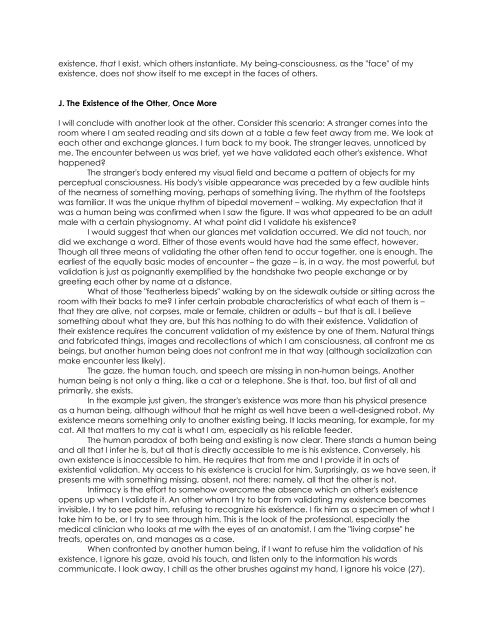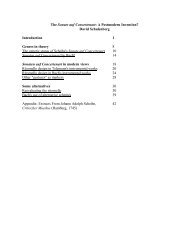SEVEN PAPERS ON EXISTENTIAL ANALYSIS ... - Wagner College
SEVEN PAPERS ON EXISTENTIAL ANALYSIS ... - Wagner College
SEVEN PAPERS ON EXISTENTIAL ANALYSIS ... - Wagner College
Create successful ePaper yourself
Turn your PDF publications into a flip-book with our unique Google optimized e-Paper software.
existence, that I exist, which others instantiate. My being-consciousness, as the "face" of my<br />
existence, does not show itself to me except in the faces of others.<br />
J. The Existence of the Other, Once More<br />
I will conclude with another look at the other. Consider this scenario: A stranger comes into the<br />
room where I am seated reading and sits down at a table a few feet away from me. We look at<br />
each other and exchange glances. I turn back to my book. The stranger leaves, unnoticed by<br />
me. The encounter between us was brief, yet we have validated each other's existence. What<br />
happened?<br />
The stranger's body entered my visual field and became a pattern of objects for my<br />
perceptual consciousness. His body's visible appearance was preceded by a few audible hints<br />
of the nearness of something moving, perhaps of something living. The rhythm of the footsteps<br />
was familiar. It was the unique rhythm of bipedal movement – walking. My expectation that it<br />
was a human being was confirmed when I saw the figure. It was what appeared to be an adult<br />
male with a certain physiognomy. At what point did I validate his existence?<br />
I would suggest that when our glances met validation occurred. We did not touch, nor<br />
did we exchange a word. Either of those events would have had the same effect, however.<br />
Though all three means of validating the other often tend to occur together, one is enough. The<br />
earliest of the equally basic modes of encounter – the gaze – is, in a way, the most powerful, but<br />
validation is just as poignantly exemplified by the handshake two people exchange or by<br />
greeting each other by name at a distance.<br />
What of those "featherless bipeds" walking by on the sidewalk outside or sitting across the<br />
room with their backs to me? I infer certain probable characteristics of what each of them is –<br />
that they are alive, not corpses, male or female, children or adults – but that is all. I believe<br />
something about what they are, but this has nothing to do with their existence. Validation of<br />
their existence requires the concurrent validation of my existence by one of them. Natural things<br />
and fabricated things, images and recollections of which I am consciousness, all confront me as<br />
beings, but another human being does not confront me in that way (although socialization can<br />
make encounter less likely).<br />
The gaze, the human touch, and speech are missing in non-human beings. Another<br />
human being is not only a thing, like a cat or a telephone. She is that, too, but first of all and<br />
primarily, she exists.<br />
In the example just given, the stranger's existence was more than his physical presence<br />
as a human being, although without that he might as well have been a well-designed robot. My<br />
existence means something only to another existing being. It lacks meaning, for example, for my<br />
cat. All that matters to my cat is what I am, especially as his reliable feeder.<br />
The human paradox of both being and existing is now clear. There stands a human being<br />
and all that I infer he is, but all that is directly accessible to me is his existence. Conversely, his<br />
own existence is inaccessible to him. He requires that from me and I provide it in acts of<br />
existential validation. My access to his existence is crucial for him. Surprisingly, as we have seen, it<br />
presents me with something missing, absent, not there; namely, all that the other is not.<br />
Intimacy is the effort to somehow overcome the absence which an other's existence<br />
opens up when I validate it. An other whom I try to bar from validating my existence becomes<br />
invisible. I try to see past him, refusing to recognize his existence. I fix him as a specimen of what I<br />
take him to be, or I try to see through him. This is the look of the professional, especially the<br />
medical clinician who looks at me with the eyes of an anatomist. I am the "living corpse" he<br />
treats, operates on, and manages as a case.<br />
When confronted by another human being, if I want to refuse him the validation of his<br />
existence, I ignore his gaze, avoid his touch, and listen only to the information his words<br />
communicate. I look away, I chill as the other brushes against my hand, I ignore his voice (27).















